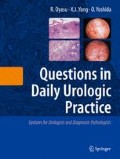Abstract
Atypical glands suspicious but not diagnostic of carcinoma indicate that the pathologic findings are not sufficient for a definitive diagnosis of cancer but suspicious enough for further investigation. Therefore, a rebiopsy should be recommended. Only a definitive diagnosis of carcinoma is an indication for therapy; a suspicious diagnosis should not lead to therapy for prostate cancer such as surgery, irradiation, or hormonal therapy.
Access this chapter
Tax calculation will be finalised at checkout
Purchases are for personal use only
References
Kisner HJ (1998) The gray zone. Clin Lab Manage Rev 12:277–280.
Epstein JI (1998) Atypical small acinar proliferation of the prostate gland. Am J Surg Pathol 22:1430.
Chan TY, Epstein JI (1999) Follow-up of atypical prostate needle biopsies suspicious for cancer. Urology 53:351–355.
Iczkowski KA, MacLennan GT, Boswick DG (1997) Atypical small acinar proliferation suspicious for malignancy in prostate needle biopsy: clinical significance in 33 cases. Am J Surg Pathol 21:1489–1495.
Murphy WM (1999) ASAP is a bad idea: atypical small acinar proliferation. Hum Pathol 30:601.
Epstein JI (1999) How should atypical prostate needle biopsies be reported? Controversies regarding the term “ASAP”. Hum Pathol 30:1401–1402.
Iczkowski KA, Cheng L, Qian J, Shanks J, Gadaleanu V, Bostwick DG, Ramnani DM (1999) ASAP is a valid diagnosis: atypical small acinar proliferation. Hum Pathol 30:774.
O’Dowd GL, Miller MC, Orozco R (2000) Analysis of repeated biopsy results within 1 year after a noncancer diagnosis. Urology 55:553–559.
Epstein JI, Herawi M (2006) Prostate needle biopsies containing prostatic intraepithelial neoplasia or atypical foci suspicious for carcinoma: implications for patient care. J Urol 175:820–834.
Jiang Z, Iczkowski KA, Woda BA, Tretiakova M, Yang XJ (2004) P504 immunostaining boosts diagnostic resolution of “suspicious” foci in prostatic needle biopsy specimens. Am J Clin Pathol 121:99–107.
Kronz JD, Shaikh AA, Epstein JI (2001) High-grade prostatic intraepithelial neoplasia with adjacent atypical glands on prostate biopsy. Hum Pathol 32:389–395.
Rights and permissions
Copyright information
© 2008 Springer
About this chapter
Cite this chapter
(2008). What is the meaning of “atypical glands suspicious but not diagnostic of adenocarcinoma” in a pathology diagnosis? Is “atypical small acinar proliferation” a pathologic entity?. In: Questions in Daily Urologic Practice. Springer, Tokyo. https://doi.org/10.1007/978-4-431-72819-1_17
Download citation
DOI: https://doi.org/10.1007/978-4-431-72819-1_17
Publisher Name: Springer, Tokyo
Print ISBN: 978-4-431-72818-4
Online ISBN: 978-4-431-72819-1
eBook Packages: MedicineMedicine (R0)

